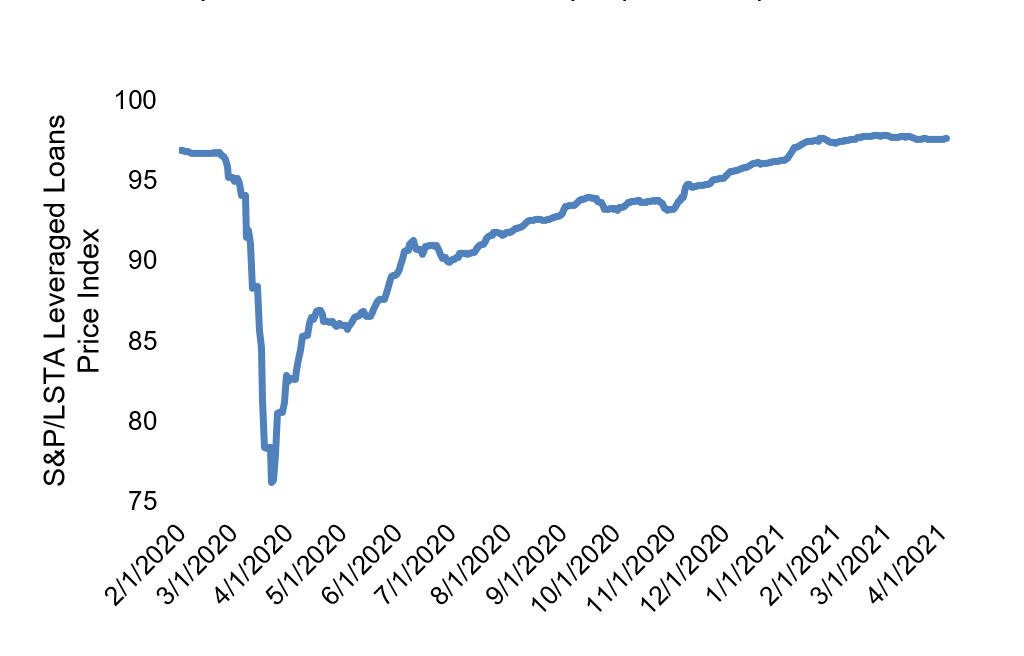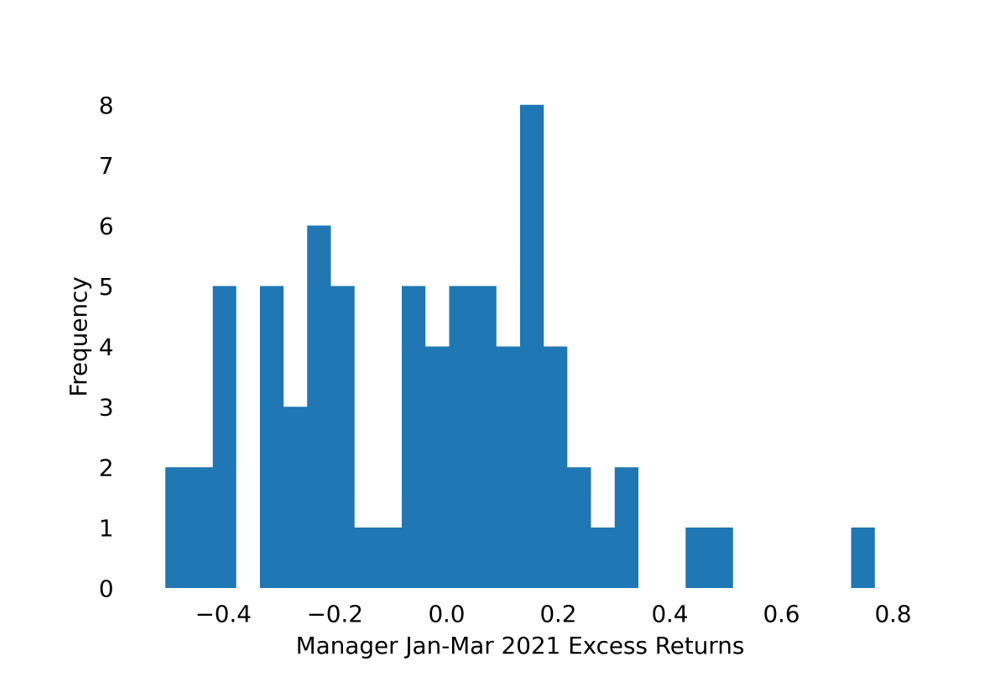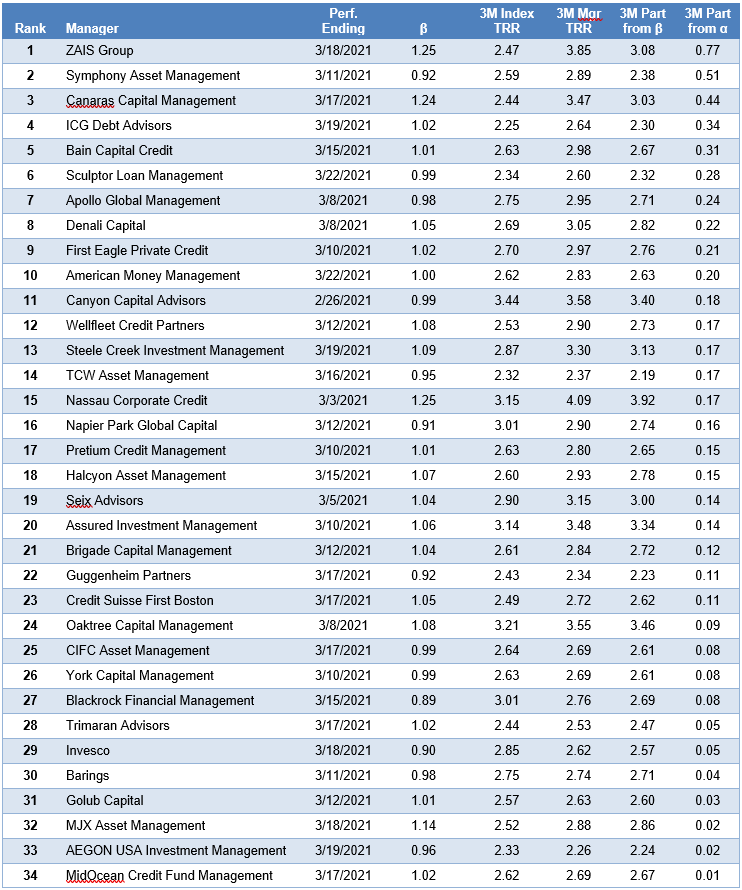Uncategorized
Managers almost catch up with the market through March
admin | April 9, 2021
This document is intended for institutional investors and is not subject to all of the independence and disclosure standards applicable to debt research reports prepared for retail investors.
Nearly half of CLO loan portfolios beat the leveraged loan market from January through March. The average CLO leveraged loan portfolio gained 2.69% and, after adjusting for broad market exposure, or beta, still trailed the market by 6 bp. Smaller managers who selected riskier loans tended to outperform their peers in the first quarter of 2021.
Loan prices remained flat between January and March, ending the run of steadily rising prices in place since last April (Exhibit 1). The loan price index remains above its pre-coronavirus level. After accounting for the various reporting dates of managers, the S&P/LSTA Total Return Index gained 2.67% between January and March. Managers held portfolios with an average beta of 1.03, which meant the average manager should have gained 2.75%. With the actual average performance at 2.69%, the average manager trailed the index by 0.06%.
Exhibit 1: Loan prices hover 3% above their pre-pandemic peak

Source: Bloomberg, Amherst Pierpont Securities
About 48% of the managers led the index, a small uptick from the figures reported by Amherst Pierpont last month (Exhibit 2). Out of the 71 managers with five or more deals tracked for January through March, two delivered alpha greater than 50 bp while none trailed the index by 50 bp or more.
Exhibit 2: Nearly half of managers outperformed the index between January and March

Note: data shows excess return only for active deals.
Source: Amherst Pierpont Securities.
The bid depth and weighted average spread of the portfolio correlated most strongly with recent excess returns (Exhibit 3). Managers who held loans that were less liquid or had higher weighted average spread delivered higher returns. Additionally, higher exposure to ‘Caa1’ loans correlated with more recent excess returns. Interestingly, the larger CLO manager’s AUM, the marginally worse its performance. Overall, managers holding riskier loans tended to outperform.
Exhibit 3: Correlation of portfolio or manager features with recent excess return

Note: data shows the correlation of manager or loan portfolio attribute with managers’ excess return or alpha from January through March only on active deals. Portfolio attributes measured as percentiles.
Source: Amherst Pierpont Securities.
The following managers delivered positive alpha in the market between January and March (Exhibit 5). ZAIS Group, Symphony, and Canaras again top the chart this time. Others in the Top 10 include ICG, Bain Capital, Sculptor, and Apollo, Denali, First Eagle and American Money Management.
Exhibit 5: Alpha leaders in CLO portfolio performance January – March 2021

Note: Performance for managers with five or more deals tracked by APS. Performance attribution starts with calculated total return on the leveraged loan portfolio held in each CLO for the 3-month reporting period ending on the indicated date. CLOs, even with a single manager platform, may vary in reporting period. The analysis matches performance in each period to performance over the identical period in the S&P/LSTA Leveraged Loan Index. Where a deal has at least 18 months of performance history since pricing and no apparent errors in cash flow data, the analysis calculates a deal beta. The deal beta is multiplied by the index return to predict deal return attributable to broad market performance. Where no beta can be calculated, the analysis uses the average beta across each manager’s active deals weighted by the average deal principal balance over time. Any difference between performance attributable to beta and actual performance is attributed to manager alpha.
Source: Amherst Pierpont Securities.
This material is intended only for institutional investors and does not carry all of the independence and disclosure standards of retail debt research reports. In the preparation of this material, the author may have consulted or otherwise discussed the matters referenced herein with one or more of SCM’s trading desks, any of which may have accumulated or otherwise taken a position, long or short, in any of the financial instruments discussed in or related to this material. Further, SCM may act as a market maker or principal dealer and may have proprietary interests that differ or conflict with the recipient hereof, in connection with any financial instrument discussed in or related to this material.
This message, including any attachments or links contained herein, is subject to important disclaimers, conditions, and disclosures regarding Electronic Communications, which you can find at https://portfolio-strategy.apsec.com/sancap-disclaimers-and-disclosures.
Important Disclaimers
Copyright © 2024 Santander US Capital Markets LLC and its affiliates (“SCM”). All rights reserved. SCM is a member of FINRA and SIPC. This material is intended for limited distribution to institutions only and is not publicly available. Any unauthorized use or disclosure is prohibited.
In making this material available, SCM (i) is not providing any advice to the recipient, including, without limitation, any advice as to investment, legal, accounting, tax and financial matters, (ii) is not acting as an advisor or fiduciary in respect of the recipient, (iii) is not making any predictions or projections and (iv) intends that any recipient to which SCM has provided this material is an “institutional investor” (as defined under applicable law and regulation, including FINRA Rule 4512 and that this material will not be disseminated, in whole or part, to any third party by the recipient.
The author of this material is an economist, desk strategist or trader. In the preparation of this material, the author may have consulted or otherwise discussed the matters referenced herein with one or more of SCM’s trading desks, any of which may have accumulated or otherwise taken a position, long or short, in any of the financial instruments discussed in or related to this material. Further, SCM or any of its affiliates may act as a market maker or principal dealer and may have proprietary interests that differ or conflict with the recipient hereof, in connection with any financial instrument discussed in or related to this material.
This material (i) has been prepared for information purposes only and does not constitute a solicitation or an offer to buy or sell any securities, related investments or other financial instruments, (ii) is neither research, a “research report” as commonly understood under the securities laws and regulations promulgated thereunder nor the product of a research department, (iii) or parts thereof may have been obtained from various sources, the reliability of which has not been verified and cannot be guaranteed by SCM, (iv) should not be reproduced or disclosed to any other person, without SCM’s prior consent and (v) is not intended for distribution in any jurisdiction in which its distribution would be prohibited.
In connection with this material, SCM (i) makes no representation or warranties as to the appropriateness or reliance for use in any transaction or as to the permissibility or legality of any financial instrument in any jurisdiction, (ii) believes the information in this material to be reliable, has not independently verified such information and makes no representation, express or implied, with regard to the accuracy or completeness of such information, (iii) accepts no responsibility or liability as to any reliance placed, or investment decision made, on the basis of such information by the recipient and (iv) does not undertake, and disclaims any duty to undertake, to update or to revise the information contained in this material.
Unless otherwise stated, the views, opinions, forecasts, valuations, or estimates contained in this material are those solely of the author, as of the date of publication of this material, and are subject to change without notice. The recipient of this material should make an independent evaluation of this information and make such other investigations as the recipient considers necessary (including obtaining independent financial advice), before transacting in any financial market or instrument discussed in or related to this material.






